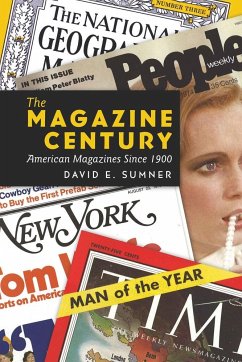The twentieth century was the magazine century in many ways. Between 1900 and 2000, the number of magazines grew from about 3,000 to 17,815 - a 593 percent increase, which exceeded population growth by 95 percent. The typical American read less than half a magazine per month in 1920, but by 2000 that figure had tripled. This book examines how and why magazines grew so rapidly. Structured chronologically by decade, it tells the stories of innovative publishers, editors, and magazines, and how and why they succeeded. Illuminating how the move from general interest to niche audiences originated early in the century - not after the rise of television - the book also shows how the growth of advertising enabled the cost of magazines to steadily decline. However, declining costs and expanding audiences brought a steady erosion in the intellectual content of magazines, illustrated by the rise in sex and celebrity titles during the 1970s and later. The book concludes with an assessment ofthe decade since 2000, and offers an optimistic outlook for the future of magazines.
Hinweis: Dieser Artikel kann nur an eine deutsche Lieferadresse ausgeliefert werden.
Hinweis: Dieser Artikel kann nur an eine deutsche Lieferadresse ausgeliefert werden.
«Taking a page from the legendary magazine publisher Henry Luce, who termed the twentieth century 'the American century', David E. Sumner aptly adapts his magazine history book and names it 'The Magazine Century'. The book scans the magazines of the twentieth century and provides the reader with a carefully crafted buffet of historical nuggets - enough to engage its audience with an amazing experience that leaves them satisfied and wanting more at the same time. The love affair with magazines that this book offers is a historical asset to anyone thinking of starting, studying, or even dreaming about launching a new magazine. It is the cornerstone of our past, from which we can live our present and better prepare for our future. A must-read for anyone who ever doubts the power of magazines and their place in our history.» (Samir Husni, Professor of Journalism and Director, Magazine Innovation Center, University of Mississippi)
«The future of magazines? Murky. Their past? Glorious. How we got from there to here is told in this compelling history. It's thrilling, funny, disturbing, sad, and ultimately inspiring. And in these pages are broad and helpful hints on how we can return to glorious.» (Richard B. Stolley, Founding Editor, 'People', and Senior Editorial Adviser, Time Inc.)
«The future of magazines? Murky. Their past? Glorious. How we got from there to here is told in this compelling history. It's thrilling, funny, disturbing, sad, and ultimately inspiring. And in these pages are broad and helpful hints on how we can return to glorious.» (Richard B. Stolley, Founding Editor, 'People', and Senior Editorial Adviser, Time Inc.)








